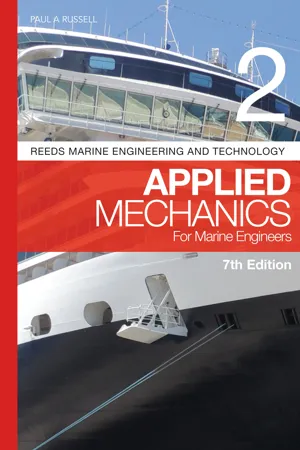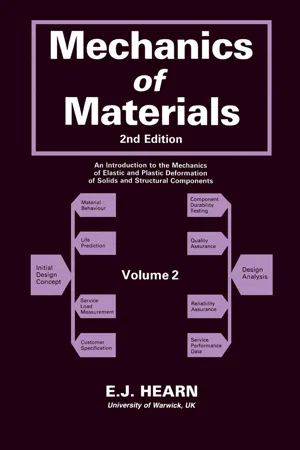Technology & Engineering
Second Moment of Area
The Second Moment of Area, also known as the moment of inertia, is a measure of an object's resistance to bending. It quantifies how the mass is distributed around an object's cross-sectional area. In engineering and technology, it is crucial for analyzing the structural behavior of beams and other components under bending loads.
Written by Perlego with AI-assistance
Related key terms
1 of 5
3 Key excerpts on "Second Moment of Area"
- Paul Anthony Russell(Author)
- 2021(Publication Date)
- Reeds(Publisher)
Therefore, referring to Figure 7.17, students will see an element of area ‘a’ at a distance of ‘h’ from the axis ‘xx’, the first moment of the area is ah, and the second moment is ah 2 . Second moments of areas are used in design calculations, particularly in calculating the strength of beams and shafts. They are usually denoted by the symbol ‘I’ with a suffix showing the axis from which the moments are taken. For instance, in Figure 7.17, I xx = ah 2 , and, if the units of area are m 2 and the distance h is in metres, then the units for I are the area in m 2 multiplied by the distance squared which is also in m 2 and therefore the answer is in m 4 . Using the symbols this formula is I = m 2 × m 2 = m 4 . The second moment of a mass is termed the moment of inertia. If m represents the mass and h its distance, then the moment of inertia is I xx = mh 2 . If an area is divided up into small elements, each element multiplied by the square of its distance from a given axis, then the summation of these products of elements of area and their (distance) 2 gives the second moment of the whole area. Taking a rectangular area of breadth B and depth D and dividing it into strips as shown in Figure 7.18: Area a x x h ▲ Figure 7.17 An element of area ‘a’ at a distance of ‘h’ from the axis ‘xx’ 170 • Applied Mechanics I a h a h a h a h a h a h ah xx = + + + + + = 1 1 2 2 2 2 3 3 2 4 4 2 5 5 2 6 6 2 2 Σ The smaller the strips, the nearer to the exact value the final result will be. If a very large (or infinite) number of very small areas, are used then integration will be used to obtain the exact value.- eBook - PDF
Mechanics of Materials
An Introduction to the Mechanics of Elastic and Plastic Deformation of Solids and Structural Components
- E. J. Hearn(Author)
- 2013(Publication Date)
- Butterworth-Heinemann(Publisher)
CHAPTER 16 UNSYMMETRICAL BENDING Summary The second moments of area of a section are given by 1 „„ = y 2 dA and 1 » = J C 2 d A The product Second Moment of Area of a section is defined as I~ u = J xYdA which reduces to I „), = Ahk for a rectangle of area A and centroid distance h and k from the X and Y axes. The principal second moments of area are the maximum and minimum values for a section and they occur about the principal axes. Product second moments of area about principal axes are zero. With a knowledge of 1 xx , 1 » and I, for a given section, the principal values may be determined using either Mohr's or Land's circle construction. The following relationships apply between the second moments of area about different axes: tan 20 = 21 ~~ ( 1 »» — I) 1 u + 1 n — I cc+ I nn The Second Moment of Area about the neutral axis is given by I n. A. = i (I ± I) ± i (I„—I„)cos 2; where ;„ is the angle between the neutral axis ( N. A.) and the U axis. Also I = I. cos 2 8± 1 1 sin 2 8 1 » = 1 n cos 2 Q + 1 „sin 2 Q 1 = 2 (1„-1„) sin2 q ~ ~x — 1» = (I„ — 1„ )cos 28 431 I u = 2 (Ixx +1») + 2 (Ixx — I) sec 20 1 n = 2 (Ixx + Iyy) 2 (I cc I) sec 20 where Q is the angle between the U and X axes, and is given by Then MOM-P 432 Mechanics of Materials Stress determination For skew loading and other forms of bending about principal axes M„ n M„ u s_ I + 1 u v where M „ and M,, are the components of the applied moment about the U and Y axes. Alternatively, with s = Px + Q y M cc = PI CU + Q I cc = — RS , — QI ~ y Then the inclination of the N.A. to the X axis is given by R tan a = — As a further alternative, M'n IN. A. where M' is the component of the applied moment about the N.A.,1 N.A , is determined either from the momental ellipse or from the Mohr or Land constructions, and n is the perpendicular distance from the point in question to the N.A. - eBook - ePub
- B W Darvell, B. W. Darvell(Authors)
- 2009(Publication Date)
- Woodhead Publishing(Publisher)
Fig. 2.14 ).Fig. 2.14 Pre-stressing always involves balanced forces.Effectively, pre-stressing also occurs in any material where there is a differential dimensional change. For example, polymerization shrinkage and water-sorption in filled resins (6§2.12 ), and in any composite or structure where there are phases of differing thermal expansion coefficient (5§5.5 ). It should be recognized that the outcome may be advantageous or disadvantageous, depending on the circumstances.§3 The Second Moment of Inertia
So far we have assumed rectangular beams, but this is plainly not a general enough system to be of use in understanding even orthodontic wires. In particular, the summation of the forces considered in connection with Fig. 2.10 above was on the assumption of symmetry about the z -axis. This is not an essential condition. What is needed is a summation over the entire area of an arbitrary cross-section, element by element, taking note of the stress acting on each. Thus, from equation 2.17 , the element of force dF acting on an area element dA is given by:dF dA= E ⋅yr c(3.1)since dF/dA is a stress. Hence, the moment of that force, from equation 1.5 , isdM dA=dF dA⋅ y = E ⋅y⋅ yr c(3.2)where y is still the perpendicular distance from the neutral surface. Integrating over the entire cross-section, equating that integral to the known (total) moment, M, of the external forces, we get:M =∫=dM dA. dA∫=E.r cy 2. dAE.r c∫y 2. dA(3.3)This rearrangement has effectively separated the elements of equation 3.2
Index pages curate the most relevant extracts from our library of academic textbooks. They’ve been created using an in-house natural language model (NLM), each adding context and meaning to key research topics.


